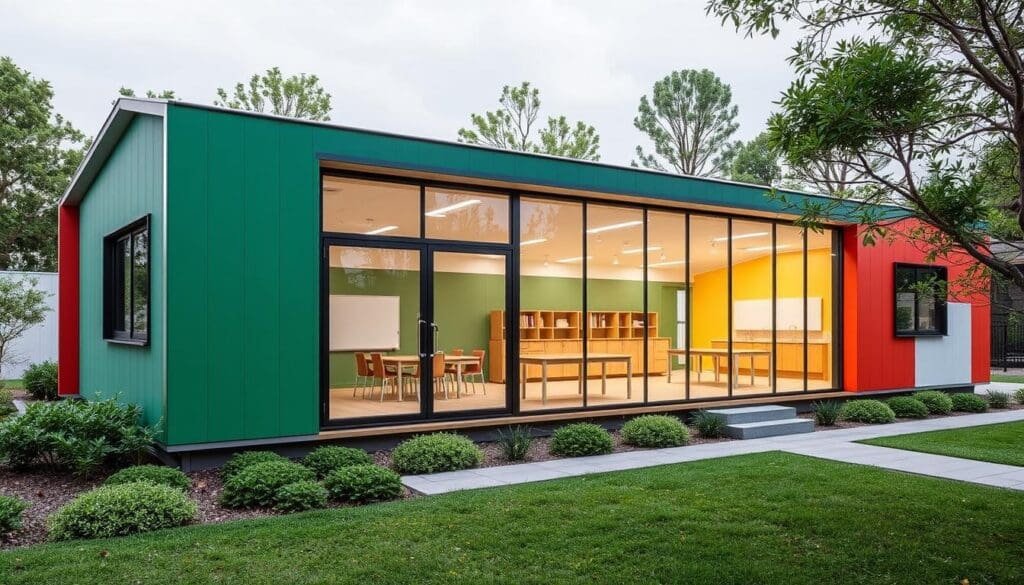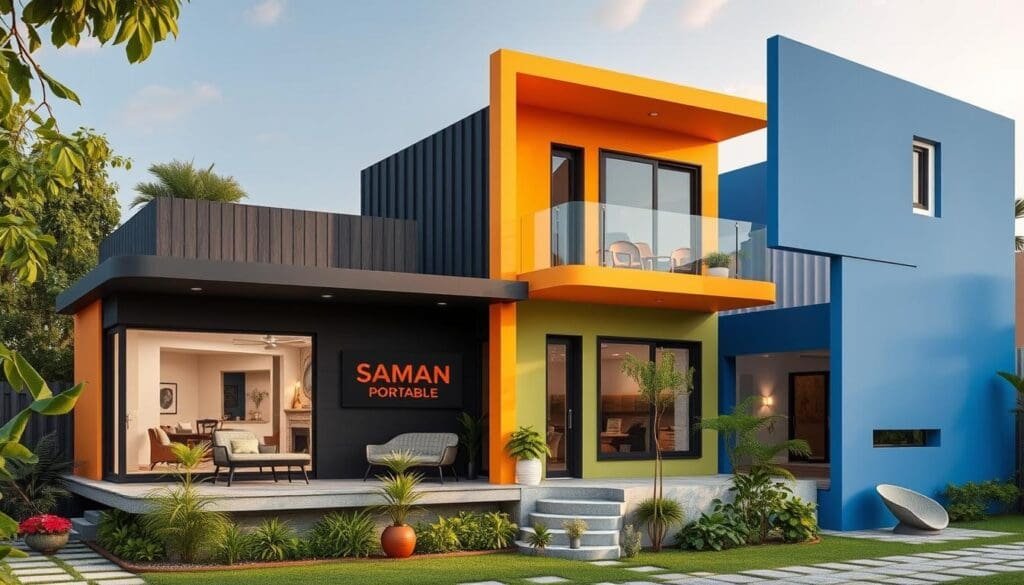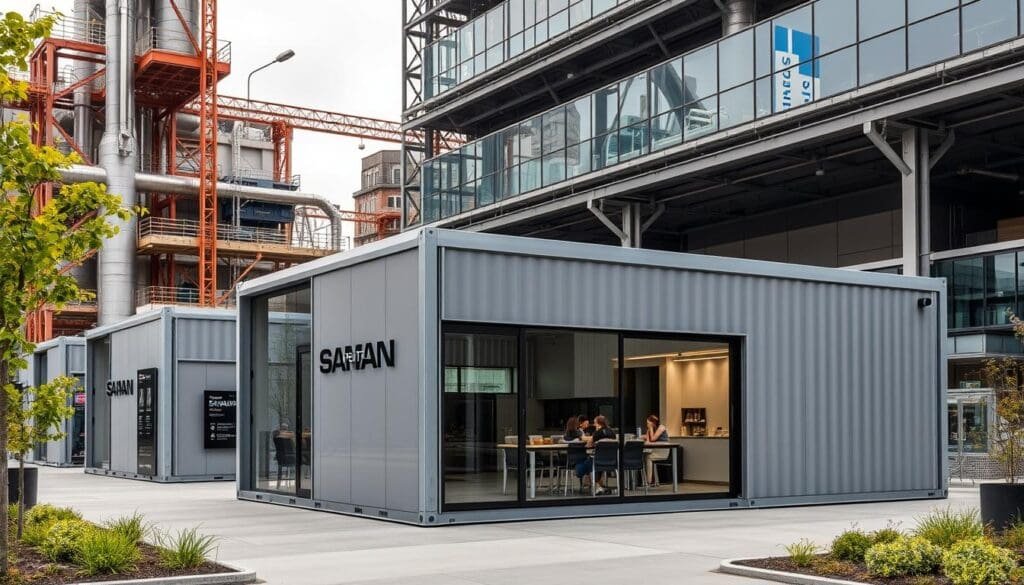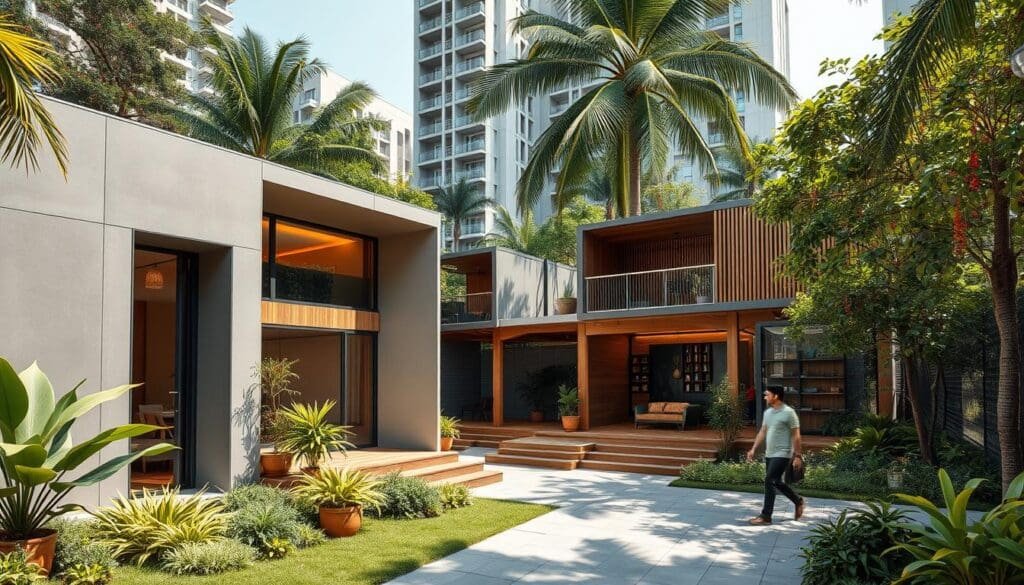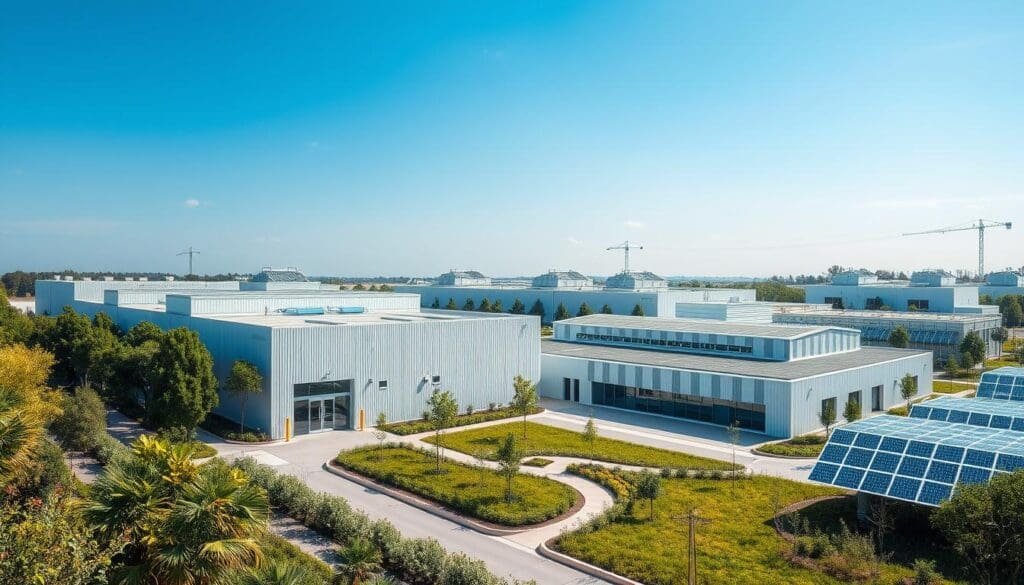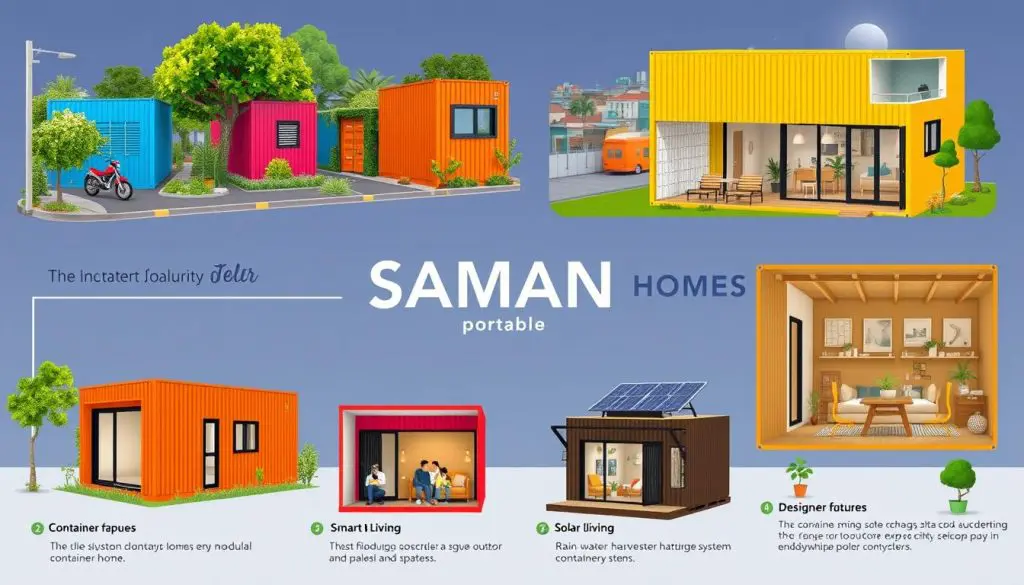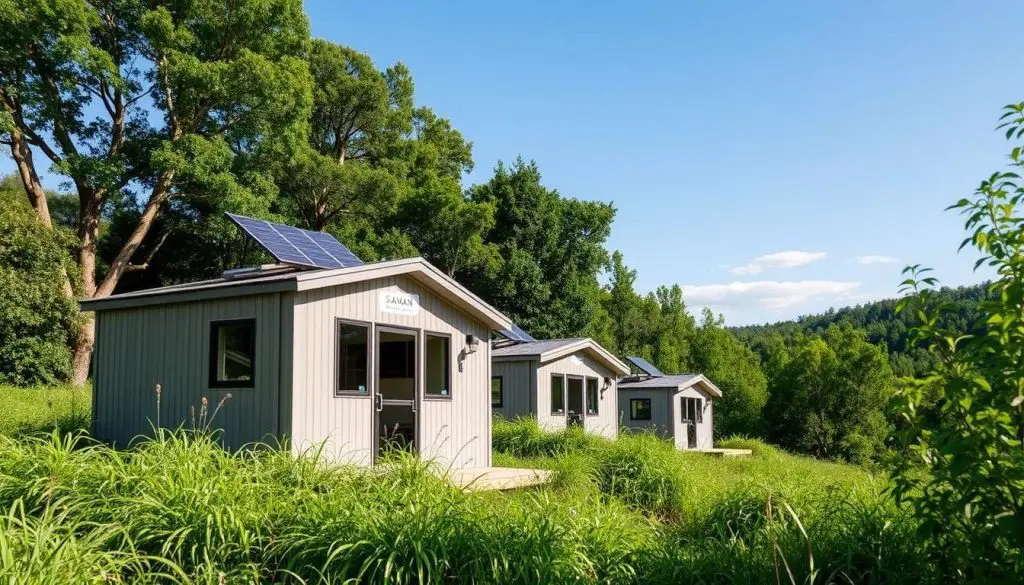Portacabin Classroom: Durable, Portable, and Perfect for Modern Education Needs
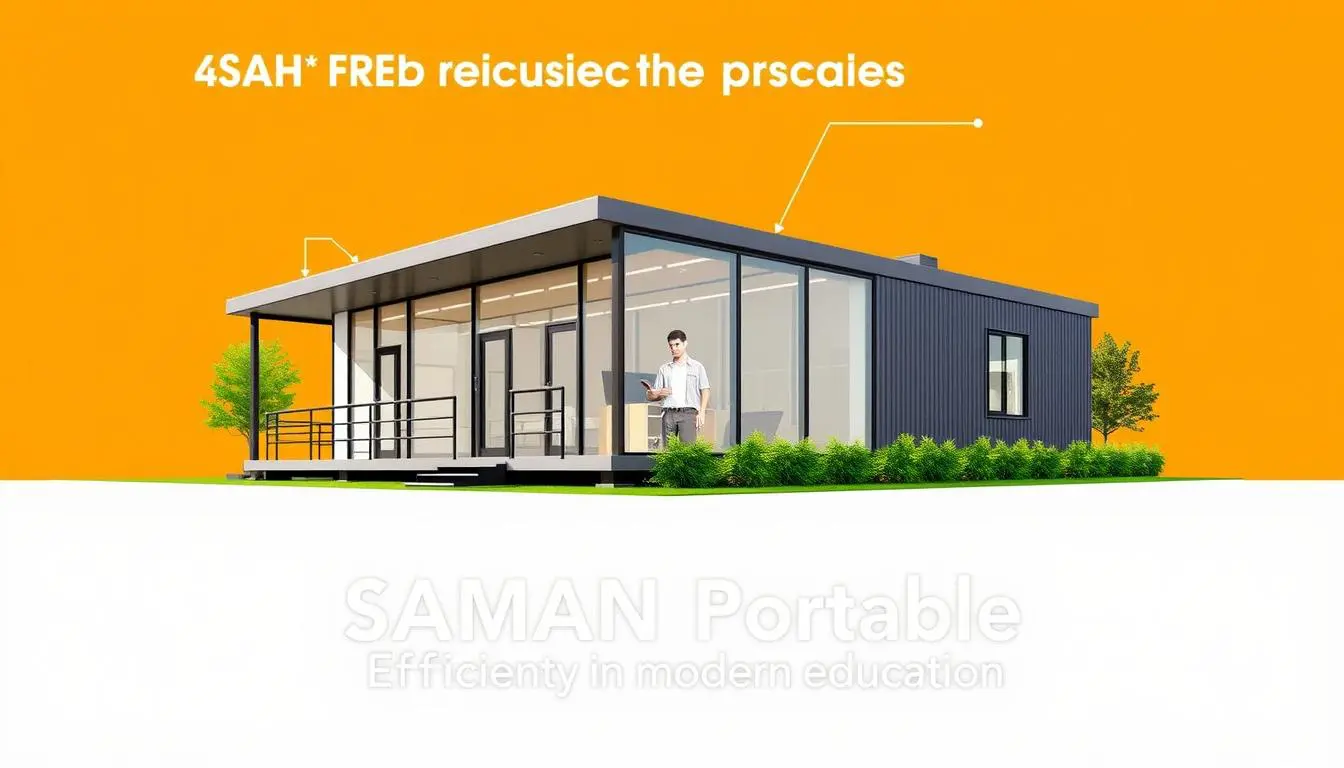
In an era of rapidly evolving educational landscapes, one question stands out: How can schools and universities adapt to the changing needs of modern students? The answer lies in the innovative solutions of portacabin classrooms – durable, flexible, and tailored to the demands of 21st-century learning.
Portacabin classrooms are revolutionizing the way we approach educational spaces, offering a practical and cost-effective alternative to traditional brick-and-mortar structures. These prefabricated, mobile units are designed to provide a comfortable and functional learning environment, while also addressing the challenges of fluctuating enrollment, evolving curriculum requirements, and the need for social distancing measures.
Key Takeaways
- Portacabin classrooms are a versatile and adaptable solution for modern educational needs.
- These portable structures can be quickly installed and reconfigured, offering flexibility to accommodate changing student populations and curriculums.
- Portacabin classrooms are equipped with advanced amenities, including climate control, integrated technology, and safety features, creating a conducive learning environment.
- These modular buildings are cost-effective alternatives to traditional construction, reducing the time and resources required for expansion or temporary classroom needs.
- Portacabin classrooms prioritize sustainability through energy-efficient design and eco-friendly materials, contributing to a greener future for educational institutions.
Understanding Modern Educational Space Solutions
As educational institutions navigate the evolving landscape, innovative movable houses and prefab portable buildings have emerged as practical solutions to meet their dynamic needs. These temporary classroom structures offer numerous benefits, providing a flexible and adaptable approach to addressing the challenges faced by modern education.
Benefits of Temporary Classroom Structures
Portable classroom buildings can be quickly deployed to accommodate growing enrollment demands, ensuring that students have access to the learning spaces they require. These modular structures can be easily reconfigured or relocated as curriculums and demographics change, making them a versatile choice for educational institutions.
Meeting Growing Enrollment Demands
With the increasing student population, movable houses and prefab portable buildings offer a practical solution to expand educational facilities. These temporary structures can be quickly assembled and installed, providing additional classroom space almost immediately to meet the rising enrollment needs.
Adapting to Social Distancing Requirements
In the wake of the COVID-19 pandemic, educational institutions have had to adapt to new social distancing protocols. Prefab portable buildings have proven invaluable in this regard, allowing schools to create extra teaching spaces or pop-up labs when needed, ensuring compliance with health and safety guidelines while maintaining an optimal learning environment.

The Evolution of Portable Classroom Buildings
Portable classroom buildings have come a long way since their humble beginnings. Once simple and utilitarian structures, today’s small portable buildings and Porta Cabins for Rent offer a level of durability, comfort, and functionality that rivals traditional brick-and-mortar constructions.
The evolution of portable classroom buildings has been driven by the changing needs of the education sector, technological advancements, and a growing emphasis on sustainability in construction. The first Portakabin, a trade name for portable buildings, was developed in 1961 in York, England by Donald Shepherd, paving the way for a new era of modular and prefabricated educational spaces.
Over the years, portable classroom buildings have become increasingly sophisticated, incorporating advanced insulation, climate control systems, and integrated technology infrastructure. These features not only enhance the learning environment but also address the growing need for flexible and adaptable educational spaces that can accommodate fluctuating enrollment and social distancing requirements.
Businesses and construction sites have also embraced the versatility of portable buildings, utilizing them for a wide range of applications, from temporary site offices to bulk storage and security cabins. The modularity and ease of assembly of these structures have made them a popular choice for situations where temporary or flexible spaces are required.
As the demand for portable classroom buildings continues to rise, manufacturers have developed a diverse range of options, from standard two-classroom units to more complex, multi-purpose modular structures. This evolution has led to a greater variety of choices in the market, allowing educational institutions and organizations to select the solutions that best fit their specific needs.

The journey of portable classroom buildings has been marked by innovation, adaptability, and a focus on providing practical and cost-effective solutions for modern educational and business requirements. As the needs of the education sector and the wider community continue to evolve, the evolution of these versatile structures is poised to continue, offering even more advanced and sustainable options for the future.
Key Features of Portacabin Classroom Designs
When it comes to modern High-Quality Porta Cabins and Luxury Porta Cabin Designs, the focus is on creating a comfortable and conducive learning environment for students. These portable classroom solutions are designed with advanced features that cater to the evolving needs of educational institutions.
Advanced Insulation and Climate Control
Portacabin classrooms are equipped with top-notch insulation and climate control systems, ensuring a consistent and comfortable temperature throughout the year. The walls, floors, and roofs are meticulously engineered to maintain optimal thermal regulation, providing a cozy atmosphere for students and teachers alike.
Integrated Technology Infrastructure
These modern portable classrooms come with seamlessly integrated technology infrastructure, supporting the latest digital learning tools and online connectivity. From high-speed internet access to integrated audiovisual systems, portacabin designs prioritize the seamless integration of technology to enhance the educational experience.
Safety and Security Measures
Safeguarding the well-being of students and staff is paramount in portacabin classroom designs. These structures feature robust construction materials, reinforced doors, and advanced security systems to ensure a secure learning environment. Rigorous safety protocols are followed to meet or exceed educational building standards.
Overall, the key features of High-Quality Porta Cabins and Luxury Porta Cabin Designs make them an ideal choice for educational institutions seeking flexible, durable, and technology-enabled classroom solutions that cater to the diverse needs of modern learning.

Cost-Effectiveness of Modular Classroom Solutions
When it comes to educational infrastructure, the cost-effectiveness of modular classroom solutions is a game-changer. Compared to traditional construction methods, these Affordable Container Offices and Portable Cabin Supplier options offer significant advantages that can benefit schools and educational institutions with tight budgets.
One of the key advantages is the reduced construction time. Recent studies in India have shown that prefab school construction can be up to 5 months faster than conventional methods, allowing schools to meet growing enrollment demands more efficiently. This expedited timeline translates to substantial cost savings, making modular classrooms an appealing choice for institutions facing budget constraints.
Sustainability is another factor that contributes to the cost-effectiveness of modular classroom solutions. With over 90% recyclable materials like steel used in their construction, these structures generate less pollution and energy consumption compared to traditional building methods. This environmental-friendly approach not only benefits the planet but also aligns with the long-term cost-saving goals of educational institutions.
Moreover, the ability to relocate and repurpose these modular structures further enhances their cost-effectiveness. EPACK Prefab, a leading Portable Cabin Supplier, has constructed over 7,400 structures in the last 24+ years, with 100 more projects currently in progress across India, demonstrating the versatility and long-term value of these solutions.

Portable cabins, in particular, offer an even more immediate and cost-effective solution, with the ability to be ready for use within a day of delivery. While the up-front costs for preparing the build site and laying foundations can range from £25-30k or more, the overall cost-effectiveness of these modular solutions is undeniable.
In conclusion, the cost-effectiveness of modular classroom solutions is a significant advantage for educational institutions seeking to optimize their infrastructure investments. From reduced construction times and sustainable materials to the flexibility of relocation and repurposing, these innovative options are transforming the way schools approach their space needs, ultimately benefiting both their budgets and the environment.
Quick Installation and Setup Process
The installation of Portable Office Cabins or Smart Portable Office Solutions is remarkably efficient and streamlined. These modular structures require minimal site preparation, often needing just a flat surface or simple foundation to get started. The assembly timeline is significantly shorter than traditional construction methods, with most Portable Office Cabins being ready for use within a matter of days or weeks.
Site Preparation Requirements
Portable Office Cabins are designed for quick and easy deployment, with site preparation requirements being relatively straightforward. The key is to ensure a stable, level surface for the cabin to be placed upon. This may involve simple ground leveling, the creation of a basic concrete slab, or the use of a pre-existing paved area. The modular nature of these Portable Office Cabins allows for seamless integration into a variety of settings, making them a versatile solution for modern workspace needs.
Assembly Timeline and Procedures
- Site inspection and preparation
- Delivery of the Portable Office Cabin components
- Assembly of the cabin structure on-site
- Connection to necessary utilities (electricity, water, etc.)
- Final inspection and handover
This rapid deployment process is particularly beneficial for organizations facing urgent space requirements or tight timelines, allowing them to quickly establish a functional workspace without the lengthy delays associated with traditional construction. The modular design and pre-fabricated nature of Portable Office Cabins enable a streamlined installation that minimizes disruption and maximizes efficiency.

Customization Options for Educational Spaces
Portable cabins and stylish container office designs are revolutionizing the way educational spaces are created and customized. These modular structures offer unparalleled flexibility, allowing schools and universities to tailor their learning environments to meet specific needs. From specialized science labs to inspiring art studios, the customization possibilities are vast.
Independent air-permeability tests have shown that these buildings perform up to 70% better than traditionally constructed buildings in terms of air quality. The precision of steel-framed modular technology ensures improved thermal efficiency, as demonstrated by air pressure tests. This attention to detail translates into healthier, more comfortable learning environments for students and teachers alike.
- Column-free interiors provide completely flexible, multi-storey layouts, enabling efficient space utilization.
- Well-ventilated rooms help reduce CO2 build-up, keeping students alert and attentive for longer periods.
- The design is tailored to meet permanent building regulations, including Part M, Equality Act, and SENDA, ensuring compliance and accessibility.
The modular approach to classroom construction also offers significant advantages in terms of speed and disruption. Modular classrooms can be operational within one week, significantly faster than traditional construction methods. This minimizes the impact on educational organizations, allowing for seamless continuity in schools, colleges, and universities.

Wernick Hire, a leading provider of modular solutions, has demonstrated the rapid deployment capabilities of these structures. They swiftly provided 11 double modular classrooms and two toilet blocks to Aylesford School within three months, addressing their urgent educational needs. Additionally, Wernick Hire assisted Tendring Technology College in addressing RAAC concerns, showcasing the reliability and efficiency of modular solutions.
The scalability of modular classrooms is also evident in the Trust’s collaboration with main contractor Morgan Sindall to plan a new building at Eden Girls Leadership Academy, aiming to accommodate 600 students. This project highlights the versatility of these solutions in meeting the growing demands of the education sector.
Ultimately, the customization options available with portable cabins and stylish container office designs empower educational institutions to create innovative, adaptable, and cost-effective learning environments that truly inspire students and support their academic success.
Environmental Impact and Sustainability Features
As we strive to create a greener future, the portacabin classroom has emerged as a shining example of sustainable innovation. These modular structures are designed with the environment in mind, incorporating energy-efficient design elements and eco-friendly materials to minimize their carbon footprint.
Energy-Efficient Design Elements
Portacabin classrooms are equipped with a range of energy-efficient features that help reduce their environmental impact. From LED lighting to high-performance insulation and energy-efficient HVAC systems, these Container Office Spaces and Compact Portable Offices are engineered to conserve energy and lower operating costs.
Eco-Friendly Materials
Many portacabin classrooms are constructed using sustainable and eco-friendly materials, such as recycled steel, aluminum, or composite panels. This not only enhances their durability and longevity but also reduces the overall carbon footprint of the construction process. The modular design of these structures further contributes to their sustainability, as they can be easily disassembled, repurposed, or recycled at the end of their lifecycle.
By incorporating these innovative sustainability features, portacabin classrooms are setting a new standard in environmentally responsible educational spaces. As we strive to create a greener future, these versatile and eco-friendly structures are paving the way for a more sustainable tomorrow.

Maintenance and Durability Aspects
When it comes to Portable Cabin Manufacturers and High-Quality Porta Cabins, the focus is on delivering durable and low-maintenance solutions for educational spaces. These modular structures are built to withstand harsh weather conditions and heavy use, thanks to their robust construction using high-quality materials like steel and advanced insulation panels.
The rugged design of Portable Cabin Manufacturers’ products minimizes the need for frequent repairs, reducing long-term maintenance costs for school districts and educational institutions. Regular upkeep is relatively simple, typically requiring basic cleaning and occasional checks of the systems and structures to ensure they remain in top condition.
- Proper ventilation is crucial to avoid dampness and mold, which can damage the cabin’s interior over time.
- Insulating the porta cabin helps maintain energy efficiency and comfort, especially during extreme weather conditions.
- Applying protective sealant or paint to the exterior helps protect the cabin from elements such as rain, snow, and sunlight, enhancing durability.
- Ensuring the porta cabin remains level at all times is vital to prevent structural damage and ensure safety.
By prioritizing maintenance and durability, Portable Cabin Manufacturers ensure that their High-Quality Porta Cabins provide a long-lasting, reliable, and cost-effective solution for modern educational needs.
Compliance with Educational Building Standards
When it comes to creating safe and effective learning environments, Luxury Porta Cabin Designs must adhere to strict educational building standards. These standards ensure that Portable Cabin Supplier solutions provide a secure and accessible space for students and staff alike.
Safety Regulations
Portacabin classrooms are designed to meet or exceed the most stringent safety regulations. This includes compliance with fire safety codes, structural integrity requirements, and other measures that prioritize the well-being of occupants. For example, Portakabin can deliver classrooms ready to go to almost any site within 24 hours, ensuring a safe and functional learning space is available when needed.
Accessibility Requirements
Inclusivity is a key consideration in Luxury Porta Cabin Designs. These portable classroom solutions are engineered to accommodate students and staff with diverse needs, integrating features that address accessibility requirements. Buildings designed by Portakabin support anti-bullying strategies with unisex toilets and open-plan communal areas, creating an inclusive environment that caters to all learners.
By adhering to educational building standards, Portable Cabin Supplier ensures that their modular classroom solutions provide a safe, comfortable, and legally compliant learning environment. This commitment to compliance allows schools and educational institutions to focus on delivering high-quality instruction, rather than worrying about the structural and safety aspects of their temporary teaching spaces.

Integrating Technology in Portable Classrooms
Modern Smart Portable Office Solutions and Customizable Portable Cabins are designed to seamlessly integrate the latest educational technology. These innovative portable classrooms feature robust electrical systems, high-speed internet connectivity, and dedicated spaces for interactive whiteboards, digital projectors, and other cutting-edge learning tools.
The integration of technology in portable classrooms enables schools to provide students with a contemporary, tech-enhanced learning experience that prepares them for the digital age. By leveraging these advanced features, educators can deliver engaging, multimedia-rich lessons that cater to the diverse learning styles and needs of their students.
- Robust Electrical Infrastructure – Portable classrooms are equipped with ample power outlets and high-capacity electrical systems to support the integration of various educational technologies.
- High-Speed Connectivity – These modular structures feature reliable, high-speed internet connectivity, allowing for seamless access to online resources, video conferencing, and cloud-based learning platforms.
- Dedicated Technology Spaces – Portable classrooms often include designated areas designed to accommodate interactive whiteboards, digital projectors, and other educational technology, creating a conducive environment for technology-driven instruction.
By embracing the potential of technology in portable classrooms, schools can provide students with a dynamic and engaging learning experience that prepares them for the demands of the 21st-century workforce. The integration of smart technologies in these flexible, customizable spaces represents a significant step forward in modern educational infrastructure.

Space Planning and Interior Design Considerations
Crafting an efficient and visually appealing portacabin classroom requires careful attention to space planning and interior design. By focusing on optimal layout configurations and strategic furniture and equipment placement, these temporary structures can become stimulating learning environments that cater to the evolving needs of modern education.
Optimal Layout Configurations
The layout of a portacabin classroom is crucial for maximizing functionality and user comfort. Factors such as natural light, traffic flow, and acoustic properties must be meticulously considered. Thoughtful zoning of the space can create distinct learning zones, promoting focused study and collaborative activities.
Furniture and Equipment Placement
Strategic placement of furniture and educational equipment is key to establishing a well-organized and adaptable portacabin classroom. Ergonomic desks, comfortable seating, and flexible storage solutions work in harmony to support both individual and group-based learning. Integrated technology infrastructure, such as interactive whiteboards and charging stations, further enhances the learning experience.
By incorporating these space planning and interior design principles, portacabin classrooms can transform into Stylish Container Office Spaces that foster creativity, collaboration, and academic success. The flexibility and customization options inherent in these modular structures enable educators to create dynamic learning environments tailored to their specific needs.
Applications Beyond Traditional Classrooms
Compact Portable Offices and Portable Office Cabins have versatile applications that extend beyond traditional classroom settings. These modular structures can be seamlessly adapted to serve as science labs, art studios, music rooms, or even administrative offices. Their adaptability makes them valuable assets for organizations seeking flexible space solutions.
In non-educational settings, these portable structures can function as temporary offices, healthcare facilities, or community centers. Their ability to be quickly installed and customized to specific needs makes them an attractive option for businesses, government agencies, and non-profit organizations alike.
- Portable Office Cabins can provide a professional and comfortable workspace for remote teams or small businesses, allowing them to establish a presence without the need for permanent infrastructure.
- Compact Portable Offices can be transformed into temporary healthcare clinics, offering accessible and efficient medical services, particularly in underserved or disaster-affected areas.
- These versatile structures can also be repurposed as community centers, providing space for educational programs, social services, or cultural events, bringing people together in a flexible and accessible environment.
The adaptability of Compact Portable Offices and Portable Office Cabins makes them invaluable assets, capable of meeting the diverse needs of modern organizations and communities. By leveraging their flexibility, businesses and institutions can unlock new opportunities for growth and sustainability.
Case Studies of Successful Implementations
The use of Porta Cabins for Rent has proven to be a game-changer in the education sector across India. Numerous case studies showcase the successful implementation of these High-Quality Porta Cabins in schools, empowering them to quickly expand capacity, create specialized learning spaces, and provide temporary facilities during renovations.
In the Bastar region of Chhattisgarh, where the literacy rate is around 40%, the government has leveraged Porta Cabins for Rent to establish “Education Cities.” These temporary classroom structures have benefited over one lakh students, helping to bring marginalized communities into the mainstream and combat Naxalism.
Similarly, in the Dantewada district, where the literacy rate is just 30.2%, Porta Cabins for Rent have played a crucial role in expanding educational access. The district’s predominantly tribal population and challenging terrain have made traditional construction methods difficult, but the rapid deployment and cost-effectiveness of High-Quality Porta Cabins have enabled the government to establish learning centers in remote areas.
The successful case studies highlight the significant impact of Porta Cabins for Rent on learning environments. Schools have reported cost savings, improved attendance, and enhanced educational outcomes due to the flexibility, durability, and adaptability of these modular classroom solutions.
Conclusion
Portacabin classrooms represent a modern, flexible, and cost-effective solution for educational space needs in India. These modular classroom buildings offer quick deployment, customization options, and sustainability features that make them an ideal choice for schools facing space challenges or seeking to innovate their learning environments.
As the education sector in India continues to evolve, portacabin classrooms stand out as a versatile and practical option for meeting the diverse needs of students and educators. With their ability to provide affordable, portable, and durable classroom structures, these solutions are well-positioned to support the growing demand for flexible and adaptable educational spaces.
By leveraging the advantages of modular classroom buildings, schools in India can create dynamic and engaging learning environments that cater to the needs of 21st-century learners. From meeting enrollment demands to adapting to social distancing requirements, portacabin classrooms offer a viable and cost-effective alternative to traditional construction methods, allowing educational institutions to focus on delivering quality education while addressing their physical space needs.
FAQ
What are the key benefits of portacabin classrooms?
Portacabin classrooms offer numerous benefits, including quick expansion to meet growing enrollment demands, adaptability for social distancing requirements, and cost-effectiveness compared to traditional construction methods.
How quickly can portacabin classrooms be installed and set up?
The installation and setup process for portacabin classrooms is remarkably quick and efficient, with minimal site preparation requirements and a timeline that is significantly shorter than traditional construction, often being ready for use within days or weeks.
What customization options are available for portacabin classrooms?
Portacabin classrooms offer extensive customization options to meet specific educational needs, from layout and interior design to specialized features like science lab equipment or art studio setups, allowing schools to create spaces that are both functional and inspiring.
How do portacabin classrooms address sustainability and environmental impact?
Modern portacabin classrooms are designed with sustainability in mind, incorporating energy-efficient features, eco-friendly materials, and construction techniques that minimize environmental impact. The modular nature of these structures also reduces construction waste and allows for easier recycling or repurposing at the end of their lifecycle.
How do portacabin classrooms ensure compliance with educational building standards?
Portacabin classrooms are designed to meet or exceed educational building standards, complying with safety regulations, including fire safety codes and structural integrity requirements, as well as incorporating accessibility features to ensure inclusivity.
What technology integration capabilities do portacabin classrooms offer?
Portacabin classrooms are equipped to support cutting-edge educational technology, featuring robust electrical systems, high-speed internet connectivity, and spaces for interactive whiteboards and other digital learning tools, enabling schools to provide contemporary, tech-enhanced learning experiences.
How do space planning and interior design considerations impact the effectiveness of portacabin classrooms?
Careful space planning and interior design are crucial for maximizing the effectiveness of portacabin classrooms. Optimal layout configurations consider factors like natural light, traffic flow, and acoustic properties, while furniture and equipment placement is strategically planned to create functional learning zones while maintaining flexibility.
Beyond traditional classrooms, what other applications do portacabin structures have?
Portacabin structures have applications beyond traditional classrooms, as they can be adapted for use as science labs, art studios, music rooms, or administrative offices. In non-educational settings, these versatile structures can serve as temporary offices, healthcare facilities, or community centers.
Can you provide examples of successful implementation of portacabin classrooms?
Numerous case studies demonstrate the successful implementation of portacabin classrooms across India, showcasing how schools have used these structures to quickly expand capacity, create specialized learning spaces, or provide temporary facilities during renovations, highlighting the cost savings, rapid deployment, and positive impact on learning environments achieved through the use of portacabin classrooms.
 Container Cafe
Container Cafe
















































































